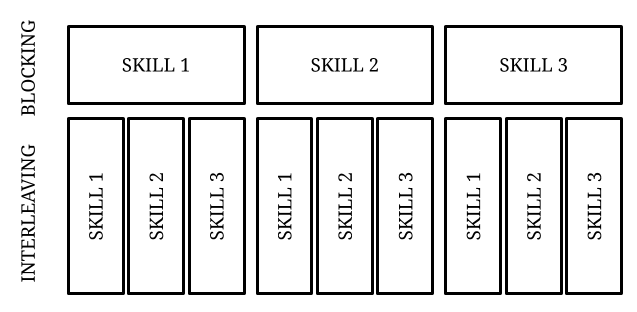Most schools use blocked practice to teach students: it’s an approach that consists in practicing a single skill over and over, with repetition being the key, and little to no variance. With blocked practice, you wait until you feel comfortable with a topic before moving onto the next one. This is how most curriculums are designed. And it’s terrible. Instead, we should use interleaving.
Interleaving is the process of mixing the practice of several related skills together. Let’s say you need to practice skills 1, 2, and 3. A blocked practice would form the pattern 111222333. And interleaved practice would form the pattern 123123123. It may seem like a simple trick, but interleaving produces dramatic benefits on learning.

Building stronger neural connections with interleaving
With blocked practice, once you know what solution to use, the hard part is over. With interleaving, each attempt is different from the past and uses different sets of information and skills, so rote responses won’t work. Your brain must stay focused on searching for different solutions. Research suggests that this improves your brain’s ability to discriminate and connect different concepts.
Studies also show that interleaving strengthens memory associations. While blocked practice works by focusing on a short-term strategy that can be temporarily held in short-term memory, interleaving forces the brain to retrieve different strategies to solve ever-changing problems. This process reinforces neural connections between different tasks and solutions, which makes learning more effective.
An interesting experiment looked at practical applications. The researchers conducted an experiment with school kids for three months. While the weekly lessons stayed the same, the weekly homework was changed: some problems featured an interleaved design and others a blocked design. A surprise test was taken one day or one month after the closing session. The results? When the test occurred one day later, scores were 25% better for problems trained with interleaving. At one month later, the interleaving advantage grew to 76%.
How to use interleaving to learn better
As effective as it is to improve learning, there are a few caveats to the use of interleaving.
- Interleaving is not multitasking. Mixing things up doesn’t mean working on several things at the same time. We are notoriously bad at context-switching, so make sure to take a short break between each activity so you can focus properly on the next one.
- Interleaving works for related topics. If you’re learning tennis, interleaving serves, backhands, and forehands is a good idea. Interleaving tennis with writing, not so much. Interleaving maths and physics may be a good idea. But maybe not for cooking and running.
- Interleaving works best for long-term learning. Because the way it works benefits mostly our long-term retention, interleaving doesn’t have the best immediate results. If you have a test tomorrow, haven’t studied, and need to remember as much as possible for a short period of time, use your rote memory instead. And next time, try to not procrastinate as much so you can give time to your brain to form stronger neural connections.
If you enjoy learning how to learn, you may like my articles about the Feynman Technique and the Art of Memory.
